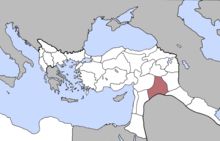| Sanjak of Zor Deyr-i-Zor sancağı | |||||||||
|---|---|---|---|---|---|---|---|---|---|
| Sanjak of the Ottoman Empire | |||||||||
| 1857–1917 | |||||||||
|
Flag | |||||||||
 Zor Sanjak in 1900 | |||||||||
| Capital | Deir Ez-Zor | ||||||||
| Area | |||||||||
• 1900s[1] | 100,000 km2 (39,000 sq mi) | ||||||||
| Population | |||||||||
• 1900s[1] | 100,000 | ||||||||
| History | |||||||||
• Established | 1857 | ||||||||
• Disestablished | 1917 | ||||||||
| |||||||||
| Today part of | Syria Turkey | ||||||||
The Sanjak of Zor[2] (Turkish: Deyr-i-Zor sancağı) was a sanjak of the Ottoman Empire, which was created in 1857. Some of its area was separated from the Baghdad Vilayet.[2] Zor was sometimes mentioned as being part of the Aleppo Vilayet,[3][4] or of the Syria Vilayet.[5]
The capital was Deir ez-Zor, a town on the right (i.e., south) bank of the Euphrates, which was also the only considerable town of the sanjak.[1] At the beginning of the 20th century, the sanjak had an area of 38,600 square miles (100,000 km2),[6] and an estimated population of 100,000, mostly Arab nomads.[1] The capital itself was just a village before becoming the centre of the sanjak.[1]
After the fall of the Ottoman Empire in 1918, Ottoman forces withdrew from the area leaving a no man's land. The region was subsequently occupied by Iraqi nationalists representing the Arab Kingdom of Syria in Damascus, and after the Paulet–Newcombe Agreement in 1923, it became part of the French Mandate for Syria.
- ^ a b c d Peters, John Punnett (1911). . In Chisholm, Hugh (ed.). Encyclopædia Britannica. Vol. 7 (11th ed.). Cambridge University Press. p. 933.
- ^ a b Peters, John Punnett (1911). . In Chisholm, Hugh (ed.). Encyclopædia Britannica. Vol. 3 (11th ed.). Cambridge University Press. p. 193.
- ^ Pavet de Courteille, Abel (1876). État présent de l'empire ottoman (in French). J. Dumaine. pp. 91–96.
- ^ Studies on Ottoman Social and Political History: Selected Articles and Essays, p. 647. Kemal H. Karpat, BRILL, 2002
″The Vilayet of Halap (Aleppo) comprised Maraş, Urfa and Zor. In 1899, a fourth sanjak, that of Antioch was formed ...″ - ^ Geographical Dictionary of the World in the early 20th Century. Logos Press, New Delhi, 1906. ISBN 8172680120
- ^ Asia by A. H. Keane, page 460
